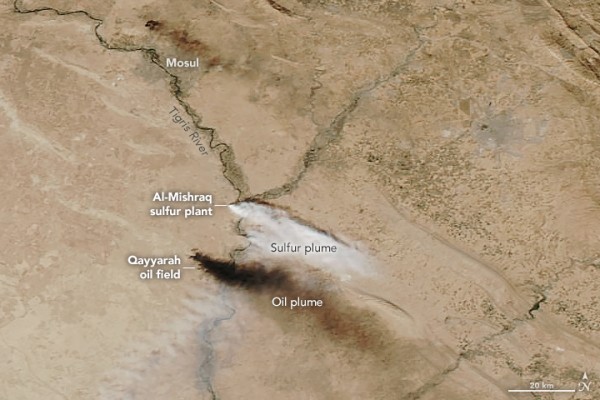By Ana Verayo, | October 28, 2016

NASA Earth Observatory images by Joshua Stevens, using data provided courtesy of the Aura OMI science team and MODIS data from LANCE/EOSDIS Rapid Response
NASA has revealed alarming new satellite images of a toxic cloud of gas spreading across the southern region of Iraq and depositing dangerous amounts of chemicals into the atmosphere.
Global News that ISIS militants torched a sulfur mine and processing facility in Al-Mishraq during a siege of Mosul. It was the last major city in Iraq that has succumbed to ISIS control. The sulfur plant has reportedly been burning for over a month now.
Like Us on Facebook
This new imagery obtained by the Moderate Resolution Imaging Spectroradiometer (MODIS) on NASA's Terra and Aqua satellites show smoke billowing across regions of Syria, Turkey and Iraq.
This highly toxic plume of sulfur dioxide is slowly growing in size, thickening and changing color, transforming into a murky, ominous cloud. Satellite data revealed a second cloud emitting from the Qayyarah oil fields. This second plume appears carbon black due to light absorbing aerosols, unlike the gray plume originating from the sulfur power plant.
Additional data from NASA's Ozone Monitoring Instrument on Aura and the Ozone Mapping Profiler Suite on Suomi NPP satellite missions reveals this massive sulfur dioxide plume was moving across the northern and central regions of Iraq.
According to atmospheric scientist Simon Carn of Michigan Technological University, the first few days after the fire, satellite observations did not show anything energetic, suggesting that sulfur dioxide remained inside the boundary layer of the lower troposphere that leads to dangerous air quality and health concerns. Recently, this sulfur dioxide cloud has now emerged to higher altitudes, undergoing long-range transport.
Inhaling small volumes from this sulfur dioxide plume can cause eye, nasal, throat, and lung irritations, while larger volume exposure can lead to difficulty in breathing, according to the Agency for Toxic Substances and Disease Registry. Around 1,000 people are receiving treatment from sulfur dioxide gas poisoning and breathing problems. Nine people have reportedly died from this incident.
-
Use of Coronavirus Pandemic Drones Raises Privacy Concerns: Drones Spread Fear, Local Officials Say

-
Coronavirus Hampers The Delivery Of Lockheed Martin F-35 Stealth Fighters For 2020

-
Instagram Speeds Up Plans to Add Account Memorialization Feature Due to COVID-19 Deaths

-
NASA: Perseverance Plans to Bring 'Mars Rock' to Earth in 2031

-
600 Dead And 3,000 In The Hospital as Iranians Believed Drinking High-Concentrations of Alcohol Can Cure The Coronavirus

-
600 Dead And 3,000 In The Hospital as Iranians Believed Drinking High-Concentrations of Alcohol Can Cure The Coronavirus

-
COVID-19: Doctors, Nurses Use Virtual Reality to Learn New Skills in Treating Coronavirus Patients







